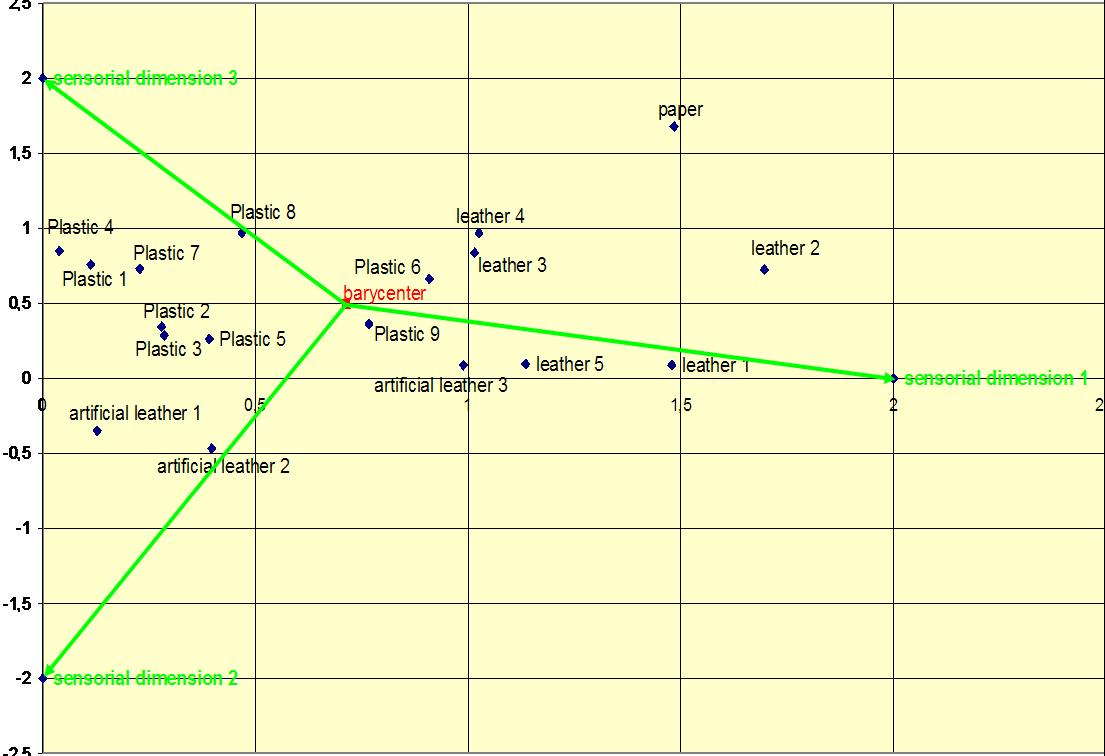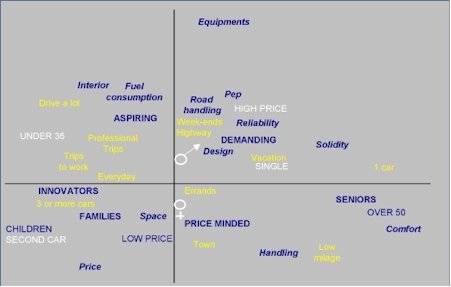


Copyrights NEXYAD 2005-2006 all rights reserved
Terms of use of images and graphics copied from this page : Policy
keywords : human factors, risk evaluation, sensory analysis, odour sensor, emotion sensor, expert systems, knowledge-based systems, driver's vigilance monitoring, driver style monitoring, customer segmentation, satisfaction survey analysis, attrition detection, questionnary denoising, multi country file fusion,
Studies that
involve human factor modeling

photos by imageafter.com
| History NEXYAD main founders, Pierre DA SILVA DIAS and Gérard YAHIAOUI were involved in the 1880's in military research for the firm AEROSPATIALE MISSILES (now a part of the European firm EADS). They developed there one of the very first french real world applications of neural networks and fuzzy logic. The applications were mainly "pattern detection", "pattern recognition", "pattern tracking", "sharp decision making", "human vision abilities modeling". Working of these tasks led to the development of a know how into : - artificial intelligence : they worked with cogniticians, psychologists, military experts, in order to model a part of the human way of reacting - artificial vision : they developed a know how on human brain modeling and especially on human vision : 1 - psycho sensorial criteria (Johnson) 2 - models of retina ("Traitement non linéaire des images : application d'un modèle biologique de la rétine", G. Yahiaoui, N. |
Azmy, J.F. Vibert,
treizièmecolloque
GRETSI,
1991), In the 1990's, they collaborated with biologists from a lab of the French Institute for Health and Medicine INSERM : biologically plausible neurons and neural networks modeling ("Critical dependence of neural networks processing on between neuron delays", N. Azmy, G. Yahiaoui, J.F. Vibert, International Conference on Artificial Neural Networks, Espoo 1991, ENNS, ed Teuvo Kohonen, Kai Makisara, Oli Simula, Jari Kangas, Finland). Then, the mix between these human factors-influenced techniques and more "classical" applied maths methods (such as signal theory, statistics, ...) that were their initial speciality, constructed a real culture of "human quantitative modeling". Since 1995 (when NEXYAD was set up), this culture were shared with every engineer and searcher of the NEXYAD team.. NEXYAD is now involved in many fields of application where this culture is a "must have". In addition, some NEXYAD engineers have a double formation (both technical sciences and human sciences). We show examples of studies, both for "technical" and "marketing" applications or research. |
"Technical" applications and research
Risk evaluation for a human car driver
| NEXYAD analyzed how the human driver evaluates the risk (of
potential accident), and developed algorithms that estimate the risk in
real time (on-board
application). |
The driver can then be aware of the potential risk of accident. |
Sensory analysis (touch, smell, sight, taste, ...)
| NEXYAD worked on many sensory analysis projects : touch,
smell, taste, acceleration feeling, ... For instance, NEXYAD worked on touch feeling of steering
wheels covered with various
materials. NEXYAD also worked on SMELL studies for car industry : car
cockpit air filters
efficiency quoting (these filters are made to cancel outside odours).
In this framework NEXYAD developed a special know-how on protocole of
measurement and experimentation (design plans, ...).
|
 |
Odour sensor
| NEXYAD developed a prototype of an odour
gas sensor : it
integrates FIGARO (metal oxyde gas sensors), pressure sensors, and
temperature sensors. The biggest work was to develop a forecasting
methods that compounds the very long time constant of gas sensors (5
minutes for absorption, 30 minutes for complete desorption). The non
linear response of gas sensors was also used in order to simulate
several sensors from one physical sensor. Classification is made with a
neural net. |
"Emotion" sensor
| NEXYAD developed a prototype of an "emotion" sensor : several conductivity sensors are used by a classifier that builds classes of "mind state". This was used for the classification of mind states of a professional sniper (before the shoot, while shooting, after the shoot). |
Expert systems development
| NEXYAD developed many expert systems (knowledge-based systems) : it consists in modeling the logic of qualitative reasonning of experts in their field of application, and then in developing a computer program that can reproduce this qualitative reasoning. | Experts systems are mostly developed for industrial projects
(process monitoring and piloting for instance). NEXYAD also applied
expert systems to marketing and sales projects where there are many
qualitative items of knowledge. |
Driver's vigilance monitoring
| NEXYAD worked on three approaches : - driver's head monitoring, through eye tracking and blink detection, - driver's behaviour monitoring : ethologists observe in situ the driver and count every behaviour occurrence. In the same time, every piloting signals are recorded (stiring wheel movement, pedals, ...). The idea is |
then to classify the signals (instrumented car) and build
classes of driver exhaust. - vigilance level monitoring using conductivity measurements inside the driver's hands. |
Driver's "style" monitoring
| NEXYAD worked on the classification of driver's style. This
classification may be used in order to adapt presets of suspensions to
the need of the customer (very comfortable when the driver is cruising,
very sport if the driver is piloting, security presets if dynamic
signals are |
recognized as a pre crash situation). It may also be used to feed the marketing teams with "real measured data on customers behaviour" (that may be correlated to declaration). |
Marketing applications and research
Customers segmentation
|
NEXYAD developed a segmentation method that filters the
declarations of
customers through the actually bough product characteristics (example :
ponderation of a customer who would declare 'i don't mind the price"
& "i want speed" that would have bought a cheap slow car). This
method automatically ponderate the items that don't bring homogeousty
of the needs.
As a matter of fact, this method leads to very homogenous
groups of
customers (in terms of needs).Example of application : segmentation of the small car market in Europe (cf. publication 1997 with the firm PSA Peugeot Citroën) |
 |
Satisfaction survey analysis
| NEXYAD developed 2 new methods for
satisfaction survey
analysis : - estimation of weight for satisfaction criteria : it is a "classical" linear way of modeling the satisfaction of customers. The idea is to give a weight to every satisfaction criteria (summ of every weights = 1). The problem seems to have an obvious maths solution : linear regression. Unfortunately, linear regression (even pls or ridge regressions) often lead to negative weights (that have no meaning : they are an artefact due to strong correlations between variables). NEXYAD recently (2004) definitively solved this problem with a formal new algorithm (no more negative weights, formal additivity property of weights, ...). - non linear modeling : the above linear modeling presumes that there exist a "compensation" effect between satisfaction criteria : "if i am very glad of this, and very annoyed by that ... i will have an average level of global satisfaction". NEXYAD could show that linear models are usually effective for customers that have a low global rate of unsatisfaction. |
But because they are those who could stop to buy,
unsatisfacted customers are very important to take into account. NEXYAD
worked on very efficient decision models : criteria of satisfaction are
not all equivalent : some HAVE to be satisfied at a very high level
while others can stand being partially satisfied. There is no
compensation effect, except between some special criteria : the
unsatisfaction for ONE criteria may lead to a complete unsatisfaction
for the global product (and then to a decision of no buy anymore).
The use of such a model brings high correlation (for instance : 95%)
between the declared global satisfaction and the predicted global
satisfaction (predicted from all declared satisfaction criteria) when
the linear modeling is usually poor (example : 65%). Such a non linear
model is also very easy to understand in a marketing point of view
(what to change in order to increase the global satisfaction for a cost
as low as possible ? ...).
|
Attrition detection
| NEXYAD developed an efficient method of sequence coding that was applied with succes to attrition detection (how to understand that a customer is about to move for a competitor ?). | Customers that are about to quit are detected, and those who
are considered as being "interesting" are contacted for a "special
offer". |
Questionnary denoising
| Studies lead to data files that are usually
very noisy. This
noise in not easy to model (it is not the result of a physical
interaction between a sensor and an experiment) because there are
several psychological effects : - taboo : direct questions about some items may lead to no answers (example, in France : how much do you earn ?). Normally this effect is not too big in surveys because psychologists perfectly know this effect, and theyr avoid to ask direct questions. - halation effect : customers don't forget their answer from a question |
to the next question. They keep in mind what they answered and modulate their current answer with their previous answers. For instance, if a customer is very angry about something, it will lead to bad marks, but not only concerning the right item : every questions asked just after the item will be answered with angryness ... Usually surveys are printed in 4 or 5 versions (rank of questions is modified for every version). From this multi-versions questionnary, NEXYAD can detect halation and cancel this noise. Of course, statistics made from denoised data are much more relevant than statistics made on rough data. |
Multi-country file fusion
|
Average levels for a given questions
(example, a question
like "do you ...", with answers like "never, sometimes, yes, always")
may be different in different countries for several reasons :
- because the people of a country don't have the same use of the product, don't have the same needs, don't have the same values, - because the people of a country don't understand the meaning of a question (their culture make the question irrelevant, forbidden, ...), - because the use for answering is different in a country (a country should answer between 5 and 10 because it is not polite to give a mark below 5 ...). |
All these differences of culture make the file fusion a very
complex
problem : only the differences due to difference of needs should be
kept, the other elements should be re-ajusted. Another complex variable is the PRICE of the bought product : levels of price are different from a country to another (food, real estate, ...) and implication into the studied product may also be different from a country to another (ex : in a country , people use to spend more than 50% of their incomes for food ? ...). NEXYAD developed methods and tools that help for data fusion. |